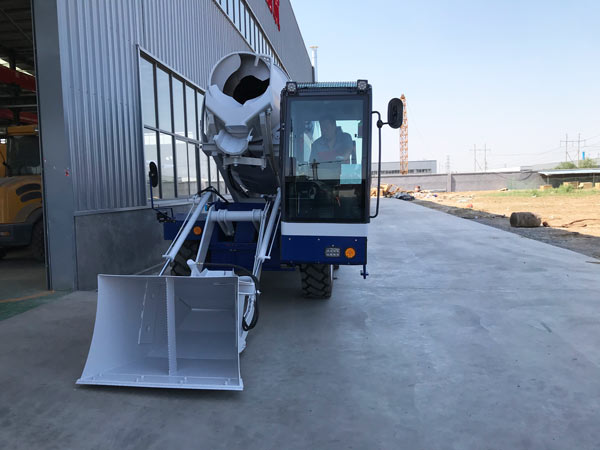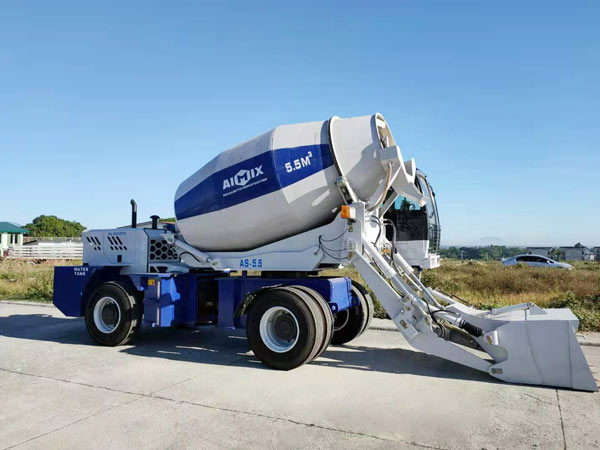


Understanding the self-loading concrete mixer’s functionality and advantages helps you make informed decisions.
Self-loading concrete mixers combine multiple functions into one machine, making tasks easier and faster. But how exactly does a self-loading concrete mixer work?
Understanding the main components of a self-loading concrete mixer is crucial. These parts work together to achieve efficient concrete mixing and transport.
The loading bucket is the first essential component. It scoops up raw materials like cement, sand, and aggregates. The bucket then feeds these materials into the mixing drum.
The mixing drum is where the magic happens. It rotates to mix the raw materials into concrete. The drum’s design ensures that the mixture is uniform and consistent.
The water system controls the amount of water added to the mix. Proper water content is crucial for concrete quality. Operators can adjust water levels based on the mix requirements.

The loading process is the first step in using a self-loading concrete mixer. This stage involves scooping up raw materials and feeding them into the mixing drum.
The operator uses the loading bucket to collect raw materials. This usually includes cement, sand, and aggregates. The bucket’s design allows for easy scooping and loading.
After collecting the raw materials, the bucket feeds them into the mixing drum. The process is quick and efficient, reducing the need for additional equipment.
Once the raw materials are in the drum, the mixing process begins. This stage is crucial for producing high-quality concrete.
The mixing drum rotates to blend the raw materials. The rotation speed can be adjusted based on the mix requirements. This ensures a uniform and consistent mixture.
Water is added to the drum through the water system. The operator can control the amount of water, ensuring the right mix consistency. Proper water content is essential for high-quality concrete.

After mixing, the concrete needs to be transported to the desired location. The self-loading mixer makes this process straightforward and efficient.
The drum can be tilted to pour the mixed concrete. This feature allows for easy and precise placement of the concrete. The drum’s design ensures minimal spillage.
The self-loading mixer is highly mobile. It can easily navigate through construction sites, even in tight spaces. This mobility makes it ideal for various construction projects.
The control system is the brain of the self-loading concrete mixer. It allows operators to manage the entire process efficiently.
The control system features a user-friendly interface. Operators can easily adjust settings like drum rotation speed and water content. This ensures optimal mixing conditions.
Many self-loading mixers come with automated features. These include automatic loading, mixing, and unloading. Automation reduces the need for manual intervention, increasing efficiency.
Proper maintenance is crucial for the longevity and performance of a self-loading concrete mixer. Regular care ensures that the machine operates at its best.
Conduct daily inspections to check for wear and tear. Inspect hydraulic lines, belts, and electrical connections. Address minor issues early to prevent major problems.
Clean the mixer drum and exterior daily. Remove leftover concrete to prevent buildup and corrosion. Use a pressure washer for effective cleaning.
Using Aimix self-loading concrete mixers offers several advantages. These benefits make them invaluable for construction projects of all sizes.
These mixers combine multiple functions into one unit. This reduces the need for separate equipment, saving time and money. The truck can load, mix, and transport concrete in one continuous operation.
Using a self-loading mixer reduces labor and equipment costs. Fewer workers are needed to operate the equipment. This results in significant cost savings for construction companies.
A self-loading concrete mixer is a valuable asset in the construction industry. Its ability to load, mix, and transport concrete in one unit offers unparalleled efficiency. This leads to significant cost savings and improved project timelines. Proper maintenance ensures long-lasting performance, making it a wise investment. Whether for small projects or large infrastructure developments, these mixers provide numerous benefits. Understanding their functionality and advantages helps you make informed decisions. Investing in a self-loading concrete mixer can revolutionize your construction operations, leading to greater success and profitability.
